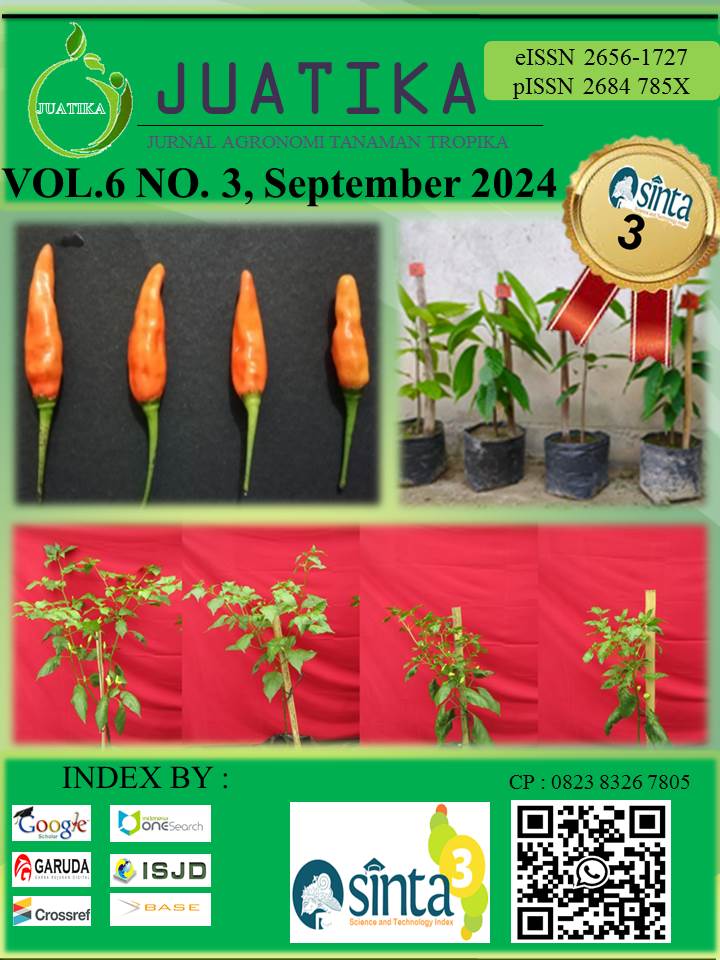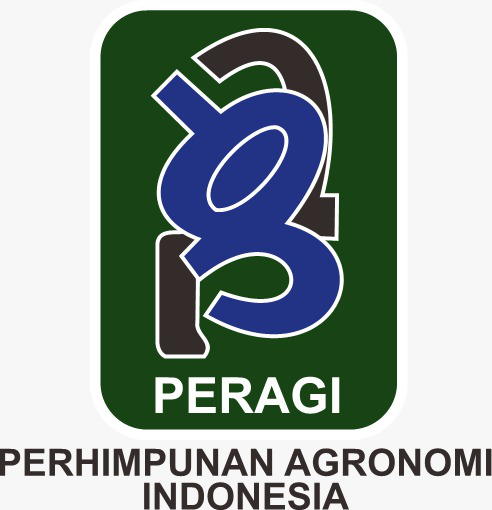Application of FMA on Soil Chemical Properties in Oil Palm (Elaeis guineensis Jacq.) plants
Abstract
Oil palm (Elaeis guineensis Jacq.) is a significant agricultural commodity in tropical regions, particularly Indonesia. The increasing demand for palm oil has prompted the expansion of agricultural land, including the utilization of marginal lands such as Dystrudepts soil, typically characterized by low fertility and a deficiency in phosphate, a critical nutrient for plant growth. One potential solution to address these limitations is the application of Arbuscular Mycorrhizal Fungi (AMF), which have been shown to enhance water availability, improve fertilizer efficiency, facilitate nutrient absorption, and increase the populations of soil microorganisms. This study aims to evaluate the alterations in the chemical properties of Dystrudepts soil following the application of Arbuscular Mycorrhizal Fungi. The research was conducted in Petapahan Village, Tapung District. The experimental treatments comprised four levels of AMF application: a control group without AMF and three treatment groups receiving AMF at doses of 150 g/plant, 300 g/plant, and 450 g/plant. Each treatment was replicated five times, resulting in 20 experimental units containing one plant. The study employed a non-factorial RAL methodology. Data were subjected to analysis of variance, followed by Duncan’s Multiple Range Test (DMRT) at a 5% significance level. The findings indicated that the application of AMF significantly affected the soil's pH, organic carbon content (C-Organic), available phosphorus (P-available), and cation exchange capacity (CEC). Notably, a dose of 300 g per plant emerged as the most effective in enhancing the chemical properties of the soil associated with oil palm cultivation.
Downloads
References
Aprilia, R. L., & Sukur. (2022). Kajian sifat fisik, kimia, dan biologi pada tanah berpasir di beberapa wilayah Indonesia. Jurnal Agroteknologi (Agronu), 1(02), 71–79. https://doi.org/10.53863/agronu.v1i02.475
Badan Pusat Statistik Provinsi Riau. (2023). Statistik kelapa sawit Provinsi Riau 2021.
Balai Penelitian Tanah. (2009). Petunjuk teknis analisis kimia tanah, tanaman, air, dan pupuk (2nd ed.). Badan Penelitian dan Pengembangan Pertanian Departemen Pertanian.
Barea, J. M., Pozo, M. J., Azcón, R., & Azcón-Aguilar, C. (2005). Microbial co-operation in the rhizosphere. Journal of Experimental Botany, 56(417), 1761–1778. https://doi.org/10.1093/jxb/eri197
Brundrett, M., Bougher, N., Dell, B., Grove, T., & Malajczuk, N. (1996). Working with mycorrhizas in forestry and agriculture. CSIRO Publishing.
Fall, A. F., Nakabonge, G., Ssekandi, J., Founoune-Mboup, H., Apori, S. O., Ndiaye, A., Badji, A., & Ngom, K. (2022). Roles of arbuscular mycorrhizal fungi on soil fertility: Contribution in the improvement of physical, chemical, and biological properties of the soil. Frontiers in Fungal Biology, 3. https://doi.org/10.3389/ffunb.2022.723892
Farzaneh, M., Vierheilig, H., Lössl, A., & Kaul, H. P. (2011). Arbuscular mycorrhiza enhances nutrient uptake in chickpea. Plant, Soil and Environment, 57(10), 465–470. https://doi.org/10.17221/133/2011-pse
Hazra, F., Gusmaini, G., & Wijayanti, D. (2019). Aplikasi bakteri endofit dan mikoriza terhadap kandungan unsur N, P, dan K pada pembibitan tanaman lada. Jurnal Ilmu Tanah dan Lingkungan, 21(1), 42–50. https://doi.org/10.29244/jitl.21.1.42-50
Herawati, A., Syamsiyah, J., & Rochmadtulloh, M. (2020). Pengaruh aplikasi mikoriza dan bahan pembenah terhadap sifat kimia dan serapan fosfor di tanah pasir. Jurnal Ilmu Tanah dan Lingkungan, 18(2).
Lǚ, L.-H., Zou, Y.-N., & Wu, Q.-S. (2019). Mycorrhizas mitigate soil replant disease of peach through regulating root exudates, soil microbial population, and soil aggregate stability. Communications in Soil Science and Plant Analysis, 50(7), 909–921. https://doi.org/10.1080/00103624.2019.1594882
Mukhlis. (2014). Analisis tanah tanaman (2nd ed.). USU Press.
Nasution, R. M., Sabrina, T., & Fauzi. (2014). Utilization of phosphate solubilizing fungi and mycorrhizae in increasing P availability and P absorption by maize on alkaline soil. Jurnal Ilmu Tanah, 2(3), 1003–1010.
Nora, S., & Mual, C. D. (2018). Budidaya tanaman kelapa sawit. Pusat Pendidikan Pertanian Badan Penyuluhan dan Sumber Daya Manusia Pertanian.
Parniske, M. (2008). Arbuscular mycorrhiza: The mother of plant root endosymbioses. Nature Reviews Microbiology, 6(10), 763–775. https://doi.org/10.1038/nrmicro1987
Putri, A. Y. Y., Irawati, I., & Armansyah, A. (2024). Response of two true shallot seed varieties to indigenous arbuscular mycorrhizal fungi inoculation. Jurnal Agronomi Tanaman Tropika (Juatika), 6(2). https://doi.org/10.36378/juatika.v6i2.3599
Rastono, A., & Firgiyanto, R. (2024). Growth and production response of cayenne pepper to phosphate-solubilizing bacteria (BPF) and arbuscular mycorrhizal fungi (FMA) in Alfisol soil in Tuban Regency. Jurnal Agronomi Tanaman Tropika (Juatika), 6(2), 173–184. https://doi.org/10.36378/juatika.v6i2.3576
Smith, J. E. (2009). Mycorrhizal symbiosis (3rd ed.). Marcel Dekker, Inc.
Suwarniati. (2014). Pengaruh FMA dan pupuk organik terhadap sifat kimia tanah dan pertumbuhan Helianthus annuus L. pada lahan kritis. Jurnal Biotik, 2(1).
Syamsiyah, J., Sunarminto, B. H., Hanudin, E., & Widada, J. (2014). Pengaruh inokulasi jamur mikoriza arbuskula terhadap glomalin, pertumbuhan, dan hasil padi. Sains Tanah-Jurnal Ilmu Tanah dan Agroklimatologi, 11(1).
Tan, K. H. (1998). Principles of soil chemistry (3rd ed.). Marcel Dekker, Inc.
Tewu, R. W. G., Lientje, T. K., & Pioh, D. D. (2016). Kajian sifat fisik dan kimia tanah pada tanah berpasir di Desa Noongan Kecamatan Langowan Barat. Jurnal Agrotek, 1(1), 1–8.
Vázquez, M. M., César, S., Azcón, R., & Barea, J. M. (2000). Interactions between arbuscular mycorrhizal fungi and other microbial inoculants (Azospirillum, Pseudomonas, Trichoderma) and their effects on microbial population and enzyme activities in the rhizosphere of maize plants. Applied Soil Ecology, 15(3), 261–272. https://doi.org/10.1016/S0929-1393(00)00075-5
Yuliatri. (2023). Respon bibit kelapa sawit (Elaeis guineensis Jacq.) terhadap pemberian beberapa dosis fungi mikoriza abuskular (FMA) di pre-nursery pada tanah ultisol. Jurnal Agrium, 20(2), 114–120.
Copyright (c) 2024 Asri Cahyati Zebua, Zulfarina, Wawan

This work is licensed under a Creative Commons Attribution 4.0 International License.
Authors who publish with Jurnal Agronomi Tanaman Tropika (JUATIKA) agree to the following terms:
Authors retain copyright and grant the Jurnal Agronomi Tanaman Tropika (JUATIKA) right of first publication with the work simultaneously licensed under a Creative Commons Attribution License (CC BY 4.0) that allows others to share (copy and redistribute the material in any medium or format) and adapt (remix, transform, and build upon the material for any purpose, even commercially) with an acknowledgment of the work's authorship and initial publication in Jurnal Agronomi Tanaman Tropika (JUATIKA).
Authors are able to enter into separate, additional contractual arrangements for the non-exclusive distribution of the journal's published version of the work (e.g., post it to an institutional repository or publish it in a book), with an acknowledgment of its initial publication in Jurnal Agronomi Tanaman Tropika (JUATIKA). Authors are permitted and encouraged to post their work online (e.g., in institutional repositories or on their website) prior to and during the submission process, as it can lead to productive exchanges, as well as earlier and greater citation of published work.







 More Information
More Information


